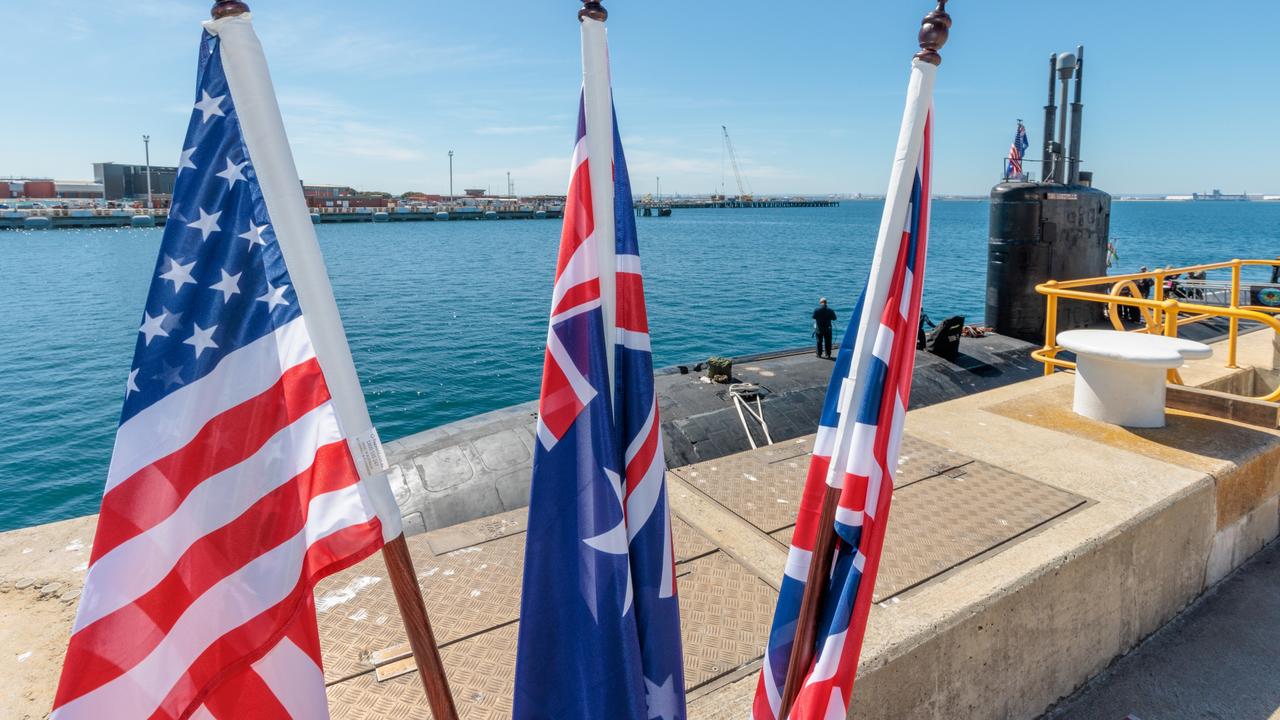China’s artificial island fortresses would be almost impossible to defeat
They’re big. They’re bristling with guns and missiles. Fighters fly above them. Warships surround them. If Beijing’s ‘sand castles’ ever go to war, they will exact a terrifying toll.

World
Don't miss out on the headlines from World. Followed categories will be added to My News.
Think the unthinkable: Beijing declares the South China Sea to be an exclusion zone. Cargo ships and commercial airliners are forced out. And Taiwan is braced for invasion.
Can anything be done about it?
Since World War II, the concept of warfare has been one of manoeuvre. Of ships, planes, tanks and troops moving rapidly — in concert — to overwhelm their surprised objectives.
It was a combat technique demonstrated with devastating effect against Iraq’s forces during Gulf Wars I & II.
Russia and China took notice.
So, in recent decades, they’ve developed a counter plan of their own.
It’s called area denial.
And Beijing has embraced this concept to the extreme.
Since 2014 it has spent billions of dollars and shifted millions of tons of sand to built controversial island fortresses on contested reefs throughout the South China Sea.
Now, they’re complete.
They may well be the ultimate military roadblock.
With the Pentagon’s top Asia official now urging Australia and other regional allies to step-up military patrols throuth these contested waters in rejection of Beijing’s claims, the potential for conflict has taken another step closer.

ISLAND FORTRESSES
China calls them weather stations, or perhaps search-and-rescue facilities.
Nobody is fooled.
Satellite and air photos have clearly shown the construction of military-grade runways, hardened hangars, underground armouries, gun towers and reinforced-concrete barracks.
Piled on artificial islands of dredged sand, these fortresses are the physical assertion of Beijing’s unilateral territorial claims over waters far from its mainland shores.
Short of war, it’s too late to do anything about them.
China has rejected an international arbitration court ruling which found its claims of historical ownership were false. Those nations that actually front the South China Sea — Taiwan, Vietnam, The Philippines, Malaysia and Brunei — don’t have the military, diplomatic or economic strength to stand against the emerging superpower of Beijing.
And many military analysts doubt even the might of the United States can breach these island defensive lines.
“What was a great wall of sand just three years ago (is now) a great wall of SAMs (surface-to-air missiles),” US commander in the Pacific Admiral Philip Davidson said in November.
It’s all about Beijing preventing any unwanted object entering the South China Sea.
Specifically, it’s what Western militaries have come to define as A2AD (Anti-Access / Area Denial).
And the top US military commander in the Pacific, Admiral Philp Davidson, has warned only war can now stop Beijing from controlling the South China Sea.
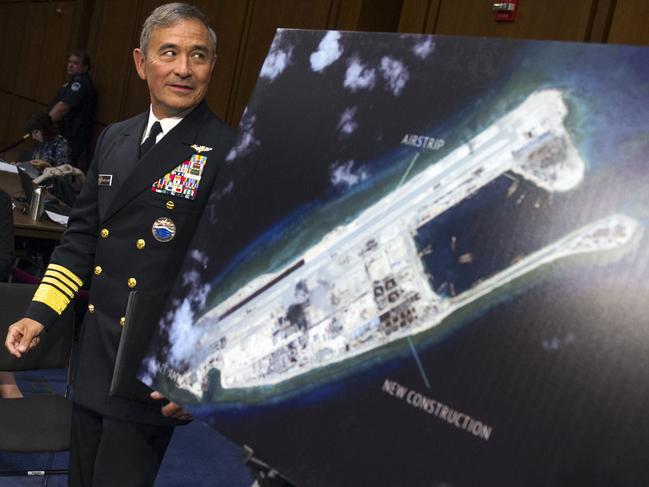
CASTLES IN THE SAND
China is building up its navy at breakneck speed. It’s placed the ships of what had been a civilian police Coast Guard under military control. But it’s also pumping out modern aircraft carriers, destroyers and submarines faster than any other nation.
At the same time, however, it has invested incomprehensible amounts into the geological engineering of its artificial island outposts.
Fiery Cross Reef, Subi Reef and Mischief Reef.
These South China Sea locations are now the most prominent of Beijing’s ‘unsinkable’ fortresses.
They are dedicated military emplacements built to control the water and sky about them.
Western military analysts have determined what weaponry has already been put in place.
There’s the HQ-9B surface-to-air missile system, similar to Russia’s S-300 recently deployed to Syria. It can shoot down anything within a 200km radius.
There’s the YJ-12B supersonic anti-ship cruise missile. It’s believed to fly at two-to-four times the speed of sound over some 400km. It may even carry a nuclear warhead.
Their expansive airfields can house, service and protect modern fighter jets such as the J-11. And they’re big enough to operate long-range strategic bombers such as the H-6K.

Spread between the Paracel and Spratly Island groups, all of these island fortresses have the ability to ‘lock down’ anything that moves between them by sea or air.
This could choke the sea lanes linking the likes of Singapore to Japan — and block military efforts to reinforce Taiwan should Beijing choose to invade the last remaining outpost of pre-Communist Republican China.
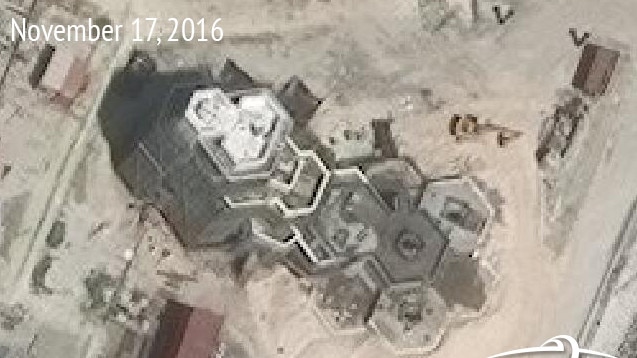
While the hangars, warehouses, gun towers and barracks of these islands can all be blasted into the coral, it would take an inordinate number of extremely expensive missiles and stealth aircraft to overwhelm the defences to do so.
And there’s little doubt the aircraft, ships and missiles deployed from these island fortresses would exact a heavy toll on anyone attempting to assail them.
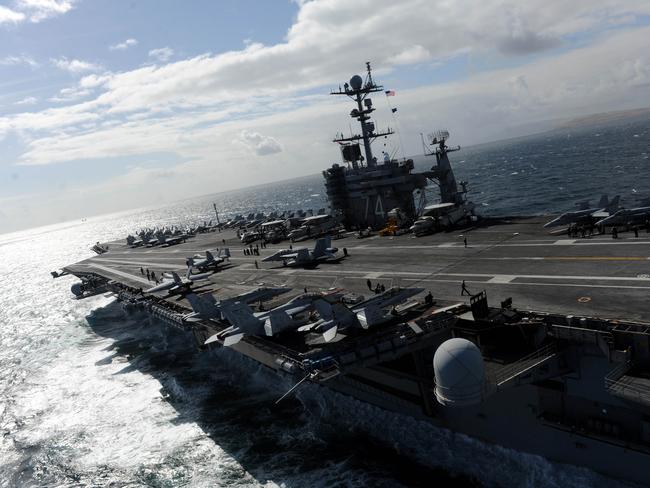
ISLAND VERSUS CARRIER
The United States has long placed great faith in the awe-inspiring strength of its aircraft carriers.
Many such ‘flat-tops’ swept through the Pacific in the final days of World War II. Naval aircraft dominated the skies above the fleet, opposing islands and Japan itself. It did come at a cost, however. The US Navy lost 10 fleet and escort carriers, with many more crippled, to enemy action.
So is the modern equivalent, the nuclear-powered super carrier, still relevant in 2018?
There are problems.
Many modern land and air launched missiles have great range. Often greater than the aircraft such enormous ships can fly, including the next-generation stealth F-35s.
While that range can be extended by the addition of tanker aircraft or drones, this naturally detracts from the room available for actual combat aircraft aboard these ships …
The once valuable ability of aircraft carriers to hide in the wide blue expanse of the Pacific is long since gone. Surveillance from space, and even ionosphere-bouncing land-based radars such as Australa’s Jindalee, will be keeping a wary eye on their every move.
And providing targeting solutions.
Escorting warships, particularly those carrying the co-ordinated Aegis radar-missile system, will probably be able to shoot down many attackers. But their missile bays are limited in number, and would likely be rapidly exhausted.
And then there’s the emergence of new ‘hypersonic’ weaponry the US fears it has no defence fast enough or accurate enough to counter.
But are aircraft carriers truly obsolete, as some analysts argue?
Guam is 3000km from the South China Sea. Pearl Harbor 8000.
Aircraft carrier battle groups still offer a powerful presence.
“Although the flat-top could be replaced by island facilities (unsinkable carriers), or even lesser floating platforms that might do the job, none can replicate its demonstrative impact,” Abhijit Singh wrote for the Lowy Institute. “Far from being a status symbol, the ship is the ‘beating heart’ of the fighting fleet that provides naval operations with an essential vigour.”
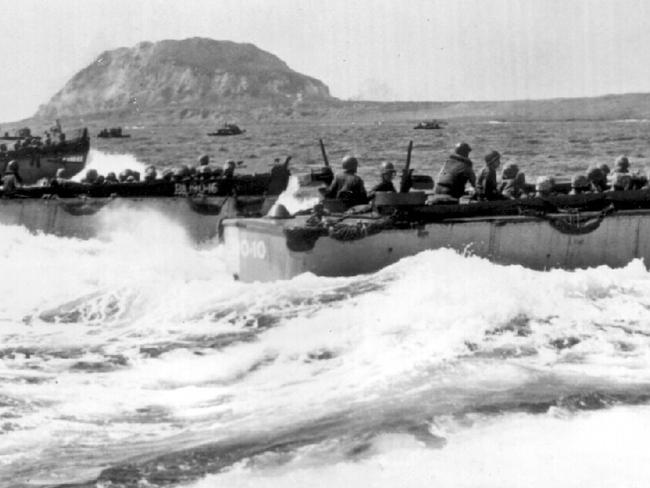
LESSONS FROM HISTORY
In World War II, the Pacific island-hopping campaign was a long and bloody affair.
Not just for the Americans.
Japan attempted to take the tiny defended Wake Island from a handful of US Marines.
The fight began just four days after the attack on Pearl Harbor, on December 11, 1941.
A few artillery pieces and a handful of aircraft were able to repel the initial Japanese attack, sinking and damaging several ships.
Japan returned later with a much more powerful force. Unopposed at sea or air, they forced the small number of defenders to surrender on December 23.
The fight taught the US several lessons, which they were to apply later during attacks on Iwo Jima and Okinawa.
These principles likely still apply today.
Attackers must outrange the defenders. This means the defenders can be worn down by long-range bombardment at relatively little expense. Questions about the relative ranges of Chinese missiles versus US carrier aircraft put this key consideration in doubt.
Air superiority is essential. Aircraft in the sky are an all-seeing eye that can reach any relevant target. In the case of China’s key island fortresses, these have unsinkable airstrips capable of supporting roughly as many, though also much larger, aircraft than US carriers. So some means — such as special forces, stealth and stand-off weapons — will need to be deployed to stop them getting into the air.
Defence is stronger than offence: Throughout history, those behind a castle’s walls held the advantage. Rest. Shelter. Supplies. Motivation. All worked in the defender’s favour. To take a medieval castle, attackers calculated they needed to outnumber defenders 10 to one. Has Beijing already made its island fortresses virtually unassailable simply by making them so hard to ‘kill’?
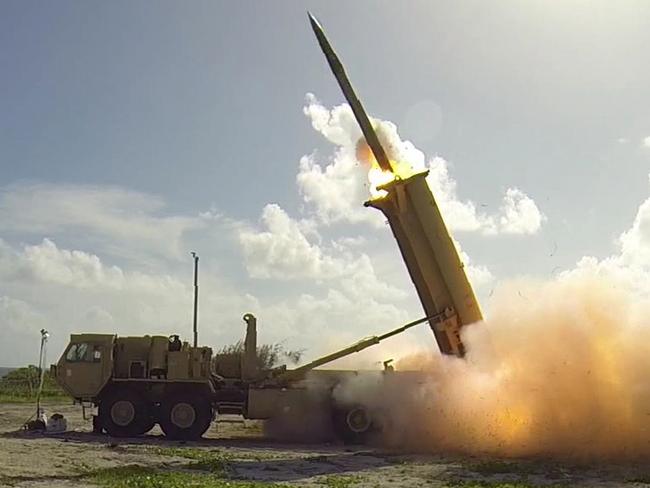
RESPONSE IN KIND
The West has warned ‘there will be consequences’ for Beijing’s moves to seize the South China Sea.
And it is starting to make moves straight out of the Chinese-Russian modern military playbook: building up missile defences on remote islands and in key strategic areas.
Japan has taken steps to improve the defence of its own territories. It’s buying two land-based facilities housing radar towers and missile launchers known as Aegis Ashore. It’s a version of the successful interceptor missile system fitted to US — and some Australian — warships. Beijing has used official channels to complain.
Mobile Patriot interceptor missile launchers and radars were recently moved into South Korea to counter North Korea’s threats. Beijing was not amused: they have the ability to peer and reach deep within its own territory, it fears.
Then there’s the United States air and naval bases on the mid-Pacific island of Guam. It has similarly been reinforced since Kim Jong-un specifically threatened it during his 2017 war of words.
Now there’s a new joint effort between Australia and the United States to restore the World War II era naval base on the northern Papua New Guinea island of Manus.
It is the final link in a network which roughly corresponds with what Beijing calls its ‘Second Island Chain’ — a geographic boundary it wants to become an outlying defensive ring.
This includes Okinawa.
Okinawa is, controversially, home to a major US naval and marine corps base. But even these facilities have a long way to go before they approach anything like that seen in the South China Sea.
“According to China, the Ryukyus started to pay tribute to China in 1372, half a millennium before they were seized by Japan, making Okinawa and the remainder of the Ryukyus simply a tributary of China,” writes Stephen Bryien in Asia Times. “No one takes China’s argument very seriously, but the intention behind it is to create uncertainty over the future of the (island) and provide China with an excuse to use political and military leverage to destabilise Japan.”
And such uncertainty may yet see more and more remote outposts turned into missile-packed fortresses intended to prevent any unwanted opponents from passing.

